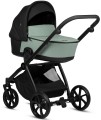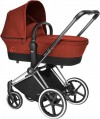Backrest tilt adjustment
The ability
to adjust the tilt between the seat and the backrest of the stroller. This helps to find the most comfortable position for the baby and adjust the seat to different situations: for example, at the end of a long walk, the backrest can be tilted back for a tired baby to take a nap.
Unit tilt adjustment
The ability to adjust
the tilt of the main unit relative to the stroller frame. This allows you to adjust the stroller to different situations: for example, at the beginning of the walk, the unit can be installed almost vertically, based on a sitting position, and later tilted back so that the baby can take a nap.
Foldable carrycot
Pushchairs in which the carrycot has a foldable design. This feature simplifies the storage and transportation of the stroller, when folded, the
foldable carrycot takes up much less space.
Carrycot carry handle
The carrycot carry handle for carrying is mounted on the carrycot and makes it easy to carry it from place to place — for example, if you need to remove the carrycot for cleaning and then put it back. The handle can have a different shape — in the form of an arc attached to the sides of the carrycot, in the form of a hood cutout, etc.
Crotch strap
The presence of a separate
crotch strap in the design of the stroller. Only pushchairs with a bumper (see above) are equipped with such a strap: it is located vertically between the legs of a seated kid, preventing him/her from falling out by slipping under the bumper. In general, this design is similar in purpose to
three-point harnesses (see “Harness type”), however, in a stroller with a bumper and crotch strap, the child is usually less crowded. You should pay attention to the presence of this function when buying pushchairs.
Viewing window
A window made of transparent or translucent material, built into the hood that covers the cradle or seating unit. In the version with a walking block,
the viewing window is usually located so that the parent can see the baby directly while moving, without being distracted from controlling the stroller. In cradles, the parent can see the child through a window by approaching the stroller from the side of the hood (that is, on the opposite side of the handle); implementations with a window in the front hemisphere of the hood are less common. In addition, a baby lying in a cradle can usually see the outside world through the window (primarily the sky above the stroller). The viewing window can be made in the form of oilcloth or a mesh mosquito net, through the holes of which air freely penetrates, but insects and small debris raised by the wind are retained.
Car seat installation
The possibility
of installing a child car seat on the chassis of the stroller. This feature can be very useful on car trips: the car seat can be used both in the car and as a seat unit for a stroller, and the main seat unit can be left at home so that it does not take up space in the boot. Note that some models with this function are initially equipped with a suitable car seat; if it is purchased separately, you should pay special attention to compatibility with your stroller.
Handle height adjustment
Possibility
to adjust the stroller handle in height. This function allows you to optimally adjust the length of the handle to the height of the parent. It will be especially useful if the parents are of different heights, and each of them regularly carries a stroller.
Typically, height adjustment is carried out by lowering or raising the upper segment of the handle, and in advanced implementations
a telescopic mechanism is responsible for it. The retractable handle makes the stroller more adaptable to different situations and conditions. For example, it can be lengthened for more comfortable walking or shortened for ease of use in tight spaces.
Frame material
The main material from which the frame of the pushchair is made.
— Aluminium. The material used in the vast majority of modern pushchairs of all price categories. This is due to a number of advantages: aluminium is light and at the same time durable, it does not rust and is not afraid of moisture, it lasts a long time, it looks nice, but it is relatively inexpensive — somewhat more expensive than steel, but noticeably cheaper than more advanced materials like carbon.
— Steel. Steel frames are as strong as aluminium frames, and they are much cheaper. On the other hand, they are quite heavy, so steel is used less often in pushchairs.
— Magnesium alloy. Premium Material: Stronger and more durable than aluminium, just as lightweight, but at a significantly higher cost. It is extremely rare, in single models of expensive pushchairs.
— Carbon. Another high-end material: carbon fiber filled with plastic. This combination gives excellent strength - comparable to steel — at a very low weight. However, carbon is very expensive, and these advantages are rarely decisive for pushchairs — in most cases simpler materials are enough. That is why carbon frames have not become widespread.
— Plastic. Plastic itself is easy to manufacture and relatively cheap; it is also not as cold to the hands in cool weather as aluminium or steel. However, modern pushchairs very rarely have frames made of this material. The fact is that low-cost vari...eties of plastic are not strong enough for this; and high-quality varieties cost accordingly - their price is close to aluminium, or even higher.
— Fibreglass. In this context, "fibreglass" typically refers to glass fibers mixed with plastic filler. Unlike conventional window glass, glass fibers are flexible and strong. The plastic filler enhances durability by offering scratch and tear resistance. The result is a material that is lightweight and very strong. However, fibreglass is prone to brittleness, especially with point impacts, and is susceptible to abrasion. As a result, it isn't widely used in pushchairs.

